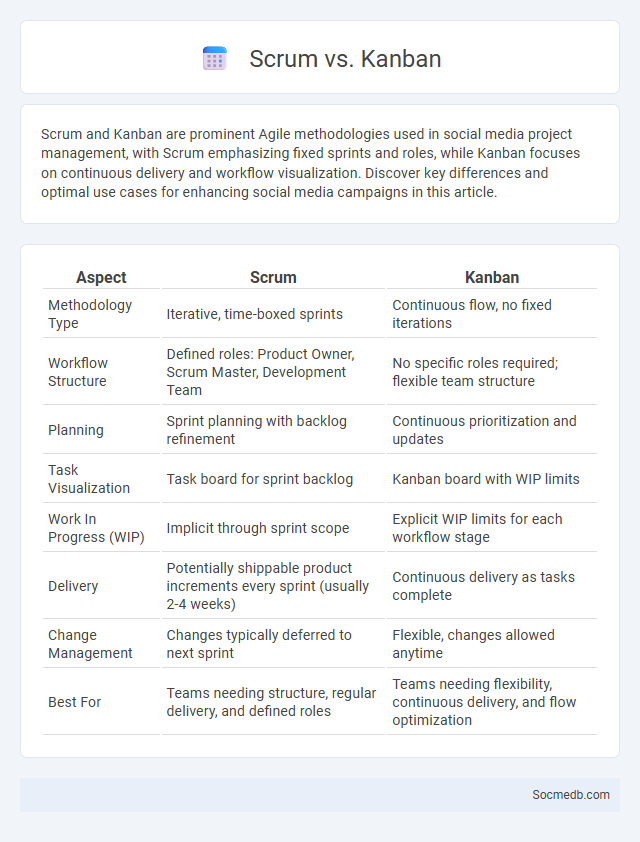
Photo illustration: Scrum vs Kanban
Scrum and Kanban are prominent Agile methodologies used in social media project management, with Scrum emphasizing fixed sprints and roles, while Kanban focuses on continuous delivery and workflow visualization. Discover key differences and optimal use cases for enhancing social media campaigns in this article.
Table of Comparison
| Aspect | Scrum | Kanban |
|---|---|---|
| Methodology Type | Iterative, time-boxed sprints | Continuous flow, no fixed iterations |
| Workflow Structure | Defined roles: Product Owner, Scrum Master, Development Team | No specific roles required; flexible team structure |
| Planning | Sprint planning with backlog refinement | Continuous prioritization and updates |
| Task Visualization | Task board for sprint backlog | Kanban board with WIP limits |
| Work In Progress (WIP) | Implicit through sprint scope | Explicit WIP limits for each workflow stage |
| Delivery | Potentially shippable product increments every sprint (usually 2-4 weeks) | Continuous delivery as tasks complete |
| Change Management | Changes typically deferred to next sprint | Flexible, changes allowed anytime |
| Best For | Teams needing structure, regular delivery, and defined roles | Teams needing flexibility, continuous delivery, and flow optimization |
Understanding Scrum: An Agile Framework
Understanding Scrum, an Agile framework widely adopted in social media project management, helps optimize team collaboration and deliver timely content updates. Your ability to break work into sprints allows iterative progress and continuous feedback, ensuring adaptability to fast-changing trends. Scrum roles like Product Owner and Scrum Master clarify responsibilities, enhancing efficiency and accountability throughout campaign development.
Key Principles of Kanban Methodology
Kanban methodology in social media management emphasizes visualizing workflow through task boards, enabling real-time tracking of content creation and publishing stages. Limiting work in progress enhances focus and reduces bottlenecks, ensuring timely delivery of campaigns and consistent engagement. Continuous improvement through feedback loops optimizes social media strategies for better audience targeting and increased ROI.
Comparing Scrum and Kanban: Core Differences
Scrum and Kanban are prominent social media project management frameworks with distinct workflows; Scrum operates in fixed sprints with predefined roles like Product Owner and Scrum Master, while Kanban emphasizes continuous delivery through visual task boards without set timeframes. Scrum's structured approach involves regular ceremonies such as sprint planning, daily stand-ups, and retrospectives, fostering iterative improvements; Kanban focuses on work-in-progress limits to optimize flow and reduce bottlenecks. Social media teams benefit from Scrum's predictability for campaign launches and Kanban's flexibility for ongoing content updates and real-time engagement tracking.
The Role of Skills Assessment in Agile Teams
Skills assessment plays a critical role in agile teams by identifying individual strengths and gaps, enabling optimal task allocation and enhancing overall team performance. Leveraging real-time feedback and continuous evaluation ensures your agile team remains adaptable and responsive to project demands. This targeted approach to skill development accelerates collaboration, innovation, and successful sprint delivery.
Integrating Skills Assessment into Scrum Projects
Integrating skills assessment into Scrum projects enhances team performance by identifying individual strengths and development areas, aligning tasks with expertise, and fostering continuous improvement. By incorporating regular evaluations through tools like competency matrices and peer reviews, Scrum teams optimize sprint outcomes and increase adaptability. This approach ensures effective resource allocation and promotes a culture of accountability and collaboration within Agile frameworks.
Implementing Skills Assessment in Kanban Workflows
Implementing skills assessment in Kanban workflows enhances team productivity by identifying strengths and gaps in real-time task management. Your social media strategy benefits from targeted skill allocation, ensuring content creation and engagement are handled by the most capable team members. Continuous evaluation within Kanban boards fosters agile adaptation and optimized collaboration.
Benefits of Combining Agile Frameworks with Skills Analysis
Combining agile frameworks with skills analysis enhances your social media strategy by enabling rapid adaptation to audience trends and improving team competency alignment. This approach boosts collaboration and efficiency, leading to more targeted content and higher engagement rates. Leveraging real-time data and continuous skills assessment ensures your social media campaigns remain competitive and effective.
Choosing the Right Approach: Scrum, Kanban, or Skills Assessment?
Selecting the right approach for your social media strategy depends on your team's workflow and project goals, whether it's Scrum's iterative sprints, Kanban's continuous flow, or targeted skills assessment for talent optimization. Scrum maximizes collaboration and adaptability through time-boxed cycles, ideal for dynamic campaigns requiring frequent feedback. Kanban enhances visual task management and efficiency, while skills assessment identifies specific competencies to tailor social media roles effectively.
Common Challenges in Agile and Skills Evaluation
Social media teams often face common challenges in agile environments, such as adapting to rapid content changes and managing cross-functional collaboration efficiently. Evaluating skills like responsiveness, creativity, and data analysis is crucial for improving your team's performance and maintaining competitive engagement strategies. Leveraging agile practices enables continuous feedback and skill development tailored to dynamic social media trends.
Best Practices for Team Success in Agile Environments
Effective communication through social media platforms enhances collaboration and transparency within agile teams, fostering real-time feedback and continuous improvement. Utilizing project management tools integrated with social media, such as Slack or Microsoft Teams, helps maintain task visibility and streamline workflow processes. Encouraging open dialogue and knowledge sharing on these platforms cultivates a culture of trust and accelerates problem-solving in dynamic agile environments.
 socmedb.com
socmedb.com